A Window Into Windex
From cleaning solutions to spray nozzles, the technology that made cleaning windows possible. And where did the word squeegee come from, anyway?
Sponsored By … You?
If you find weird or unusual topics like this super-fascinating, the best way to tell us is to give us a nod on Ko-Fi. It helps ensure that we can keep this machine moving, support outside writers, and bring on the tools to support our writing. (Also it’s heartening when someone chips in.)
We accept advertising, too! Check out this page to learn more.
“Finally, a grand flooding takes place, and the decks are remorselessly thrashed with dry swabs. After which an extraordinary implement—a sort of leathern hoe called a ‘squilgee’ is used to scrape and squeeze the last dribblings of water from the planks. Concerning this ‘squilgee,’ I think something of drawing up a memoir, and reading it before the Academy of Arts and Sciences. It is a most curious affair.”
— A passage from Herman Melville’s 1850 work White-jacket: or, The world in a man-of-war, a novel published just a year before his 1851 masterwork Moby Dick. The word Melville uses is an early form of the better-known “squeegee,” a device that became closely associated with window cleaning, especially when used with window wipers on cars or done by professional window cleaners on the sides of large buildings. As World Wide Words notes, the term competed with “squeegee” for decades as the one most commonly used, although “squeegee” was first. Much as in Melville’s reference, it was initially used in a nautical context.
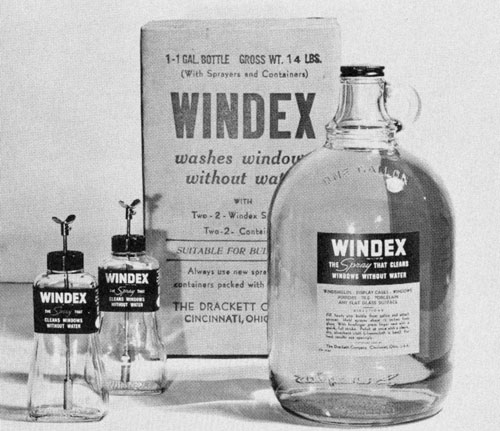
(Handout photo)
How Windex grew into a household name from scratch
The 1933 invention of Windex wasn’t the first major innovation to come from the Philip W. Drackett Company—that was Drano, the powdery lye-and-aluminum-and-dyed-salt solution that came about in the early 1920s. That once-a-week drain concoction was invented by Philip and his son, Harry. (The elder Drackett died just a few years later, in 1927.)
The company came to its success in consumer products after expanding from its roots as a maker of industrial chemicals. That can be a tough jump to make, but the company was able to pull it off in no small part thanks to smart marketing—formulated by Sally Drackett, Philip’s wife, who came up with the name and the symbol over the ā, to ensure proper pronunciation.
A decade after finding its footing in the consumer market, Harry followed up by coming up with household window cleaner—something that proved a winner for the company. Like his dad, Harry looked at consumer trends of the era: Like indoor plumbing’s growth immediately after World War I, windows were having a moment in the Great Depression era. Cars used them, obviously, and they were becoming a common part of homes.
But it was not necessarily a good moment for a new window cleaner—at least on the surface.
“[T]he timing seemingly could not have been worse,” Cincinnati Post reporter Barry M. Horseman wrote in 1999. “It was the depth of the Depression, when clean windows were the least of many American families’ concerns. This was a marketing nightmare compounded by having to compete not just with other similar products but with ‘free’ water.”
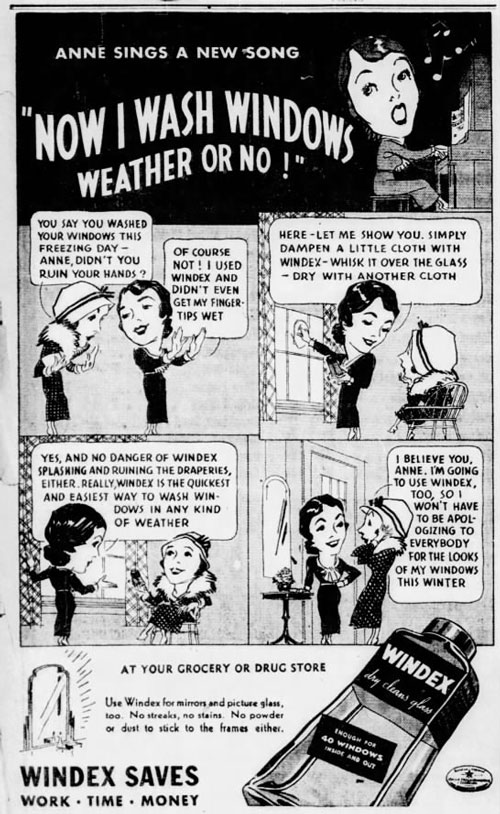
A 1935 Windex ad. The product, after its 1933 invention, took a couple of years to get to market. (The Courier-Journal)
Eventually, though, things would become clear. Windex would eventually become a big hit for Drackett and its corporate successors—arguably bigger than Drano became, which is saying a lot.
First focusing on the car market, the company quickly found a place for its product in homes, in no small part to all the windows that needed to be cleaned.
(Side note: Windex a great example of why you shouldn’t simply rely on a Wikipedia entry in doing research. The page for the chemical strongly implies that Windex was initially a highly flammable material that was only sold at first in a metal spray container, with its current form only coming through reformulation. But the claim, which dates back to an unsourced 2006 addition to the encyclopedia and has appeared in books written after the addition date, lacks firm ground: A 75th anniversary press release makes no reference to the metal cans, while ads in 1935 show glass bottles, not cans, and advertising dating as far back as 1943 specifically claims the material isn’t flammable. Metal cans didn’t come about until the late 1950s. That said, evidence that the spray was reformulated is common knowledge.)
But there’s something else that Drackett deserves credit for that the Windex bottle may be responsible for popularizing, and that’s the container that the not-safe-to-drink chemical comes within.
“My dad believed in two things: That Greeks should educate non Greeks about being Greek and every ailment from psoriasis to poison ivy can be cured with Windex.”
— Toula Portokalos, Nia Vardalos’ character from My Big Fat Greek Wedding, setting the stage for what is perhaps the greatest pop-culture-related moment involving Windex. (We don’t recommend using Windex as a treatment for anything, other than dirty windows.) It’s certainly less depressing as a pop-culture moment as the relatively recent meme of people “drinking” Windex on YouTube—of course, replacing the blue window cleaner with Gatorade or Powerade.
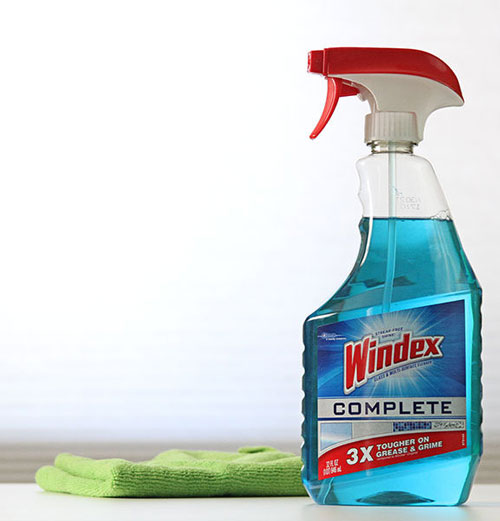
The modern-day spray bottle had some indirect influence from Henry Ford and soybeans
The weird thing about Drackett was that Windex and Drano were not the only things going on with the company at the time. The firm had a relationship with Henry Ford, who had an interest in using soybeans as building block for manufacturing.
Ford worked closely with George Washington Carver on this endeavor, with the duo hoping to use their smarts in agriculture and manufacturing (along with Ford’s massive soy fields) to help create items that would eventually forge new industries by killing two birds with one soybean.
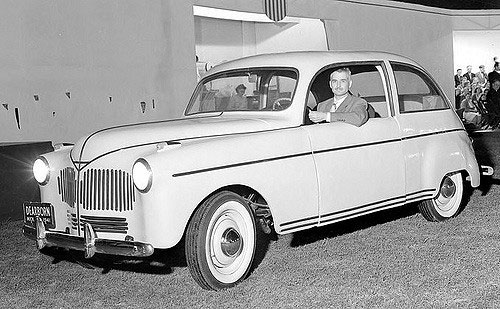
The Soybean Car. (John Lloyd/Flickr)
Most notably, this led to the creation of the “Soybean car,” a device that was made almost entirely with naturally-occurring plastics derived from soy, hemp, and other versatile plants. It was a weird idea. (Did it inspire the Chevrolet stepvan made from marijuana, as featured in Cheech and Chong’s Up in Smoke? We’ll never know.)
The car turned out to be a bit of a bust, but their experimenting did help Drackett, which had interests in Ford’s soybean endeavors as well as a few of its own, move into plastics—a crucial part of the success of the spray bottle. The firm, notably, announced a kind of fabric produced from soybeans named Azlon, as part of the company’s diversification efforts. That effort came about directly because it bought a business from Ford.
And that diversification turned back to the spray bottle the company sold with bottles of Windex. (Well, usually. There’s at least one example of Windex being advertised without any spray functionality at all.)
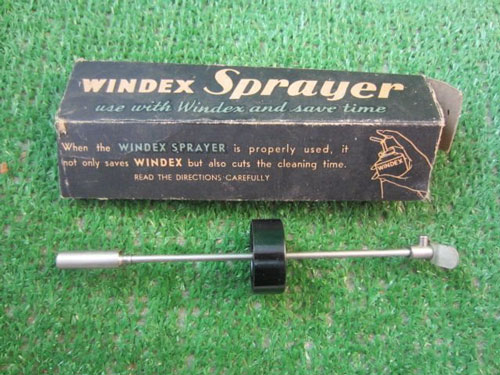
A standalone Windex sprayer. (Kooky Kitsch)
Over the years, Drackett sold its sprayers in a variety of styles, including a metal nozzle that you press down on. One early plastic model was reminiscent of the sprayers on bottles of the modern sore throat medicine Chloraseptic. Early on—out of a mixture of necessity due to the fragile nature of early plastics, and to encourage re-use—the company even sold Windex sprayers separately, rather than including them with the solution.
During this same period, Drackett had built a reputation for experimenting with soy-based plastics, which likely helped inspire much of the company’s work on its spray bottle designs, even if much of that soy-based plastic never actually made it to market.
Eventually, Drackett moved away from soybeans entirely, in part because the sector was pushing them toward food production rather than industrial uses. (Nearby Worthington, Ohio, noted for its influence on meat analogues, was among those that pushed Drackett to use their formidable soy resources for making veggie food.) But the move toward plastics in general stuck—with the company continuing to improve its spray-bottle designs.
Drackett was eventually bought out by larger companies, and its brands are now a part of S. C. Johnson & Son. But the efforts the company put into spray bottles helped drive the cleaning industry forward.
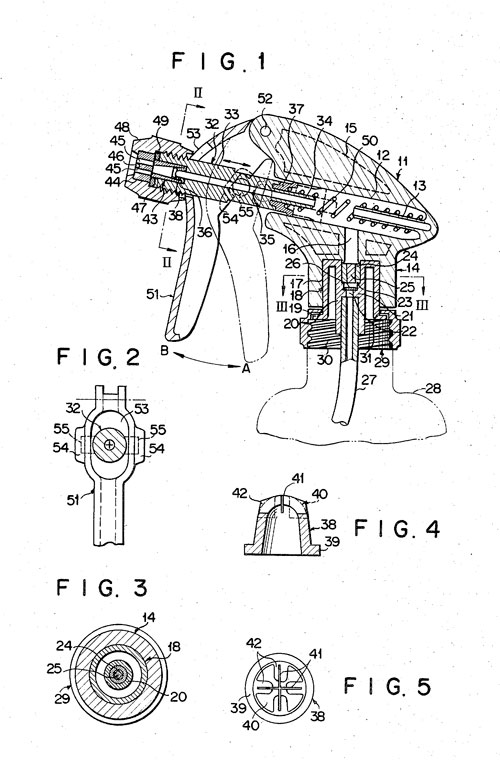
One of Tetsuya Tada’s many patents on trigger spayers. (Google Patents)
Eventually, the industry found a solution for cleaning supplies that proved especially effective: The gun-style trigger sprayer, an invention of Japan’s Tetsuya Tada in the late 1950s, quickly took over the cleaning supplies aisle of the grocery store. Windex headed in that general direction, itself, moving toward its now-standard design by the ’70s.
Tada, who died in 2015, was heartfelt about the effect that his engineering work had on the broader world.
“I firmly believe that all of this is making a humble but significant contribution to the current protection of the ozone layer, which is so essential to all life on our planet including, of course, mankind,” Tara wrote on the website for his company, Canyon Corporation.
It’s a quiet innovation—certainly, we don’t talk about it much—but it probably did in fact change the world for the better.
1936
The year that Italian immigrant Ettore Steccone filed a patent for the modern form of the squeegee, a device that improved upon professional window-washing tools significantly. “The main object of the present invention is to provide a Squeegee that is operative to remove liquids and dirt efficiently, within a wide range of angles and a wide range of pressures,” the patent filing stated. Ettore, a company founded by Steccone and still active to this day, is held up as the gold standard of squeegee-based window washing.
Window cleaning is kind of a dull job, even with tools like Windex and squeegees to simplify things. And even if you work on a skyscraper—inside or out.
But sometimes, the basic window cleaning tools represent more than that. Sometimes, window cleaning can even save the day.
A fairly dramatic example of this is the squeegee that helped a group of six men get out of an elevator at the World Trade Center on September 11, 2001. In a quite tense moment, Ukranian immigrant Jan Demczur and five other men were stuck in an elevator that had stalled at the 50th floor of the World Trade Center’s North Tower. They were able to pry the elevator doors open, but as they were on an express elevator, there was no entrance on the other side—they would have to make one.
They had no proper tool to help with this, as a blade fell out of Demczur’s hands, down an elevator shaft. Demczur had his squeegee, but the rubber part of the squeegee also fell down the shaft. For an hour and a half, the men used the only tool at their disposal, the brass handle of a squeegee, to cut through the wall and out to safety, making it out of the elevator with only minutes to spare.
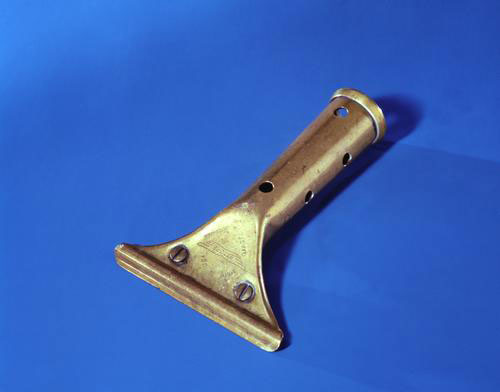
This squeegee handle saved six lives. (National Museum of American History)
The six men survived, and the dramatic story gained the attention of both the Smithsonian—which added the handle to its 9/11 collection in the National Museum of American History—and the window cleaning industry as a whole. American Window Cleaner magazine made Demczur its cover story in December of 2001, with Demczur portrayed in a superhero costume on the magazine’s front cover.
And Ettore Products, the manufacturer of the squeegee that saved the men’s lives, stepped up as well, holding an event in honor of the survivors at a New York restaurant, and giving each of the six men—five of whom were professional window washers—both a full-size squeegee and a diamond-studded gold pin shaped like a squeegee. (The company also donated to relief efforts.)
On an incredibly dark day otherwise, it was a shining moment for a fundamental tool—even if, in that moment, there were no windows to be seen.
:format(jpeg)/2017/06/tedium061317.gif)
/2017/06/tedium061317.gif)


/uploads/ernie_crop.jpg)